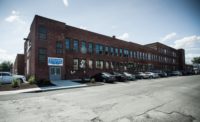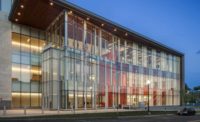The replacement and restoration of the historic skylight within the landmark Manhattan Surrogate’s Courthouse has received a 2020 Lucy G. Moses Preservation Award from the New York Landmarks Conservancy. The team for this highly complex project included Urbahn Architects, program manager the New York City Department of Design and Construction (DDC), owner the New York City Department of Citywide Administrative Services (DCAS), and historic conservator Jablonski Building Conservation (JBC).
The Lucy G. Moses Awards are the New York Landmarks Conservancy’s highest honors for preservation excellence. The award will be bestowed upon the project team on September 23, 2020, during the 30th Anniversary Lucy G. Moses Preservation Awards Gala to be held at The Cathedral Church of Saint John the Divine in Manhattan.
Completed in 1907, this Beaux-Arts structure encompasses an entire block in downtown Manhattan, bounded by Chambers, Centre, Reade, and Elk Streets. The interior and exterior are both New York City Landmarks. The building was also placed on the National Register of Historic Places in 1972 and designated a National Historic Landmark in 1977. The building holds the city’s municipal archives and features ornate courtrooms for New York County’s Surrogate’s Court on the fifth floor.
R. Thomas, one of the United States’ most sought after architects of public edifices in his day, designed the seven-story building. Thomas considered this building his masterpiece. The opulent three-story atrium features a 40 foot by 60 foot skylight that soars overhead, allowing natural light to flood in, illuminating the rich and highly articulated interiors. The Paris Opera purportedly inspired the skylight, and in fact, when the court building was completed it was called the most Parisian structure in New York.
While many of the courtyard’s sumptuous finishes were imported from Europe, the skylight was fabricated just a couple of dozen blocks north of the building itself, in Chelsea. The monumental atrium space features an extraordinary double staircase of Tuscan marble imported from Siena, which leads to upper-level balconies. The walls and columns are lined with matching Siena marble, with blood-red marble roundels and elaborate carvings that include garlands of fruit and foliage. Mosaic murals by William DeLeftwich Dodge feature the signs of the zodiac. For the floor, the original architect chose pink marble from Tennessee and blue marble from Belgium, laid out in geometric patterns. When it was built, this atrium was the grandest, most expensive, and most controversial – due to the cost and opulence – part of the building.
The original skylight monitor actually consists of two separate glazed assemblies with an interstitial space in between. The outer assembly faces the sky and provides protection from the weather. The interior glass layer, or “laylight,” is seen by the public from within the atrium, and is therefore treated in a highly ornamental fashion. In addition to its visual function, the laylight provides code-required occupant protection from potentially falling glass. The monitor that projects from the roof is gable-shaped, with glass panels originally supported by a copper frame structure with a ridge at its peak. Ten clerestory windows are on the vertical sides where the skylight drops to a walkway that stretches around its perimeter. The walkway extends along the built-in gutters at two sides and consists of hexagonal glass block set within cast iron panels. The laylight within the atrium is comprised of hundreds of translucent glass panels set in an ornamental bronze clad cast iron frame forming a monumental barrel vault.
Based on Urbahn’s design, the renovation team removed the entire outer monitor system and replaced it with a new copper-anodized aluminum frame to emulate the original copper frame cladding. The team oversaw the fabrication of a new aluminum frame to hold the glass panels. Several new copper elements were fabricated to match the originals, including leaders, gutters, and a ridge vent replicating the original ornate rope motif.
For the laylight, Urbahn and JBC developed a procedure that called for removing the glass panels to facilitate the restoration of the leading that holds the glass in place, as well as provision of new glass to replace missing or broken panes. The bronze cladding was stripped of all coatings, cleaned, and refinished in situ.
The design team addressed the inherent vulnerability of the glass block walkway to water infiltration by designing a new protective assembly, including laminated glass protecting the glass blocks, with new durable aluminum panels as a walking surface, all within a new metal frame system. The team replicated the original hexagonal glass blocks, which are 1-½" thick, 3-½" wide, with groups of blocks forming a total of 24 glass panels running on two sides of the skylight.
“Working within a cherished historic edifice such as Surrogate’s Court required a team that is attuned to the aesthetics, materials, and building practices of another age, as well as well versed in both the limitations and advances of modern construction technologies,” explained Rafael Stein, AIA, an Urbahn Principal. “For example, the two lunettes on either end of the atrium had been so damaged that it was nearly impossible to understand what they had once looked like. Our research revealed that there had in fact been different decorative layers over time. We selected the most recent iteration and developed a restoration approach based on review of archival photographs and an analysis of multiple paint and plaster coats. We then carefully specified the design so that the lunettes could be lovingly restored by experienced artisans.”
Although the skylight first began to leak in the 1990s, rehabilitation was postponed because of the near constant use of the building. In addition to its municipal use, the building hosts major public and private events and is rented out as a film set. By the time the restoration had begun, the atrium’s grandeur was diminished by the damaged and grimy skylight and extensive damage to adjacent materials, including marble and plaster.
“There was water damage to the cornices beneath the skylight. The original marble was extremely difficult to match, so, in all locations where damaged marble was in prominent view, we carefully pinned the sections together,” said Stein.
In addition to DCAS, DDC, Urbahn, and Jablonski, the team included construction manager The LiRo Group; general contractor BQE Industries, Inc.; and structural engineer Ysrael A. Seinuk. Instrumental subcontractors included Bovard Studio, Inc., which restored the laylight glass; Wemco Casting, LLC, which produced the cast iron frames; Gillinder Brothers, Inc. which cast the new glass blocks; Linel, which fabricated and installed the skylight; and EverGreene Architectural Arts, which recreated the lunettes and the ornamental bronze cladding that encases the skylight’s steel structure. EverGreene also painted the repaired plaster to match the marble panels.
Complex Logistics
The construction team was operating in a tight space within a historic structure, so logistics were carefully planned. First, crews erected barricades within the atrium to safeguard the public while they installed a working platform resting on scaffolding, with a stair access to the skylight from below. The construction team also provided temporary roof to make the atrium watertight during construction. The temporary roof consisted of steel beams spanning the courtyard, with metal deck and waterproof membrane. These components were hoisted over the building’s main roof and assembled in place over the skylight within the courtyard, surrounded on all sides by the Court building’s tower. Select skylight components designated for removal were manually disassembled and hoisted down within the building from the working platform. The temporary roof was then disassembled and removed by crane from the street, once the renovation was completed. In addition, there were multiple security restrictions, as the building remained a working courthouse that required heightened security. Security personnel constantly monitored each entrance. As it is an occupied building, there was also an increased need for noise control; the construction team had to carefully coordinate their work with tenants.
Due to the grandeur of the atrium, the interior is often used as the backdrop for the filming of movies and commercials, and it is frequently rented out as an event space. The television show “Law and Order”, “The Devil Wears Prada” and “Great Expectations” movies, and many other productions feature scenes shot within the building. Construction could not commence until the multitude of such pre-booked shoots and events taking place immediately below the skylight work occurred. No events were scheduled during the construction period.
Some of the original steel frame elements supporting the skylight were corroded or missing due to years of water infiltration and deferred maintenance. Overall, the project involved a great deal of on-site research, because there were no original drawings. Engineering consultant Ysrael A. Seinuk PC prepared new drawings based on field measurements and developed a restoration method for the structural aspects of the project. “We found that numerous structural elements that support the skylight had to be replaced or reinforced,” noted Salvatore Paratore, AIA, LEED AP, the Project Manager for the work and a Senior Associate at Urbahn. “For the temporary roof, we lifted the steel up for installation using a hoist set up on a scaffolding platform above the work area. All of the other materials and equipment were brought up by an internal hoist,” Paratore added.
Restoration Process Details
JBC worked with Urbahn and DDC and DCAS to develop a scope of work and procedures to repair and restore the historic elements on the interior and at the skylight level. Prior to any work beginning, Urbahn’s team surveyed and documented the existing conditions, including the exterior skylight monitor, leaded glass laylight panels, the bronze-clad barrel vaulted frame, and the plaster lunettes. The design team conducted their survey from a lift so that materials could be inspected up close. The design team also surveyed the skylight’s elements from within the interstitial space between the monitor and laylight.
The inspection included documenting each of the glass laylight panels, including the condition of the leading and the glass panes. The top-facing, unfinished side of the bronze was in good condition. However, because the bronze cladding concealed the cast-iron frame, the full extent of corrosion from water infiltration was not evident until the construction phase. During design, Urbahn and JBC determined that a significant percentage of the glass blocks at the exterior walkway were cracked or missing, thereby requiring casting of replacement blocks and frame to replicate these elements. The plaster substrate of the lunettes had blistered and much of the paint was peeling.
Mary Jablonski, JBC’s Principal, also noted that scaffold access revealed multiple unforeseen conditions, including marble spalls, cracks, and losses on the cornice. “Many of the marble spalls were due to corrosion of the structural steel, which was assessed and then repaired. Work on the marble cornice could not be completed until the scaffold was modified to provide a lower work platform below the cornice fascia. Once the work platform was modified, the marble cornice and fascia were vacuumed to remove dust and debris. Then they were cleaned using a latex-based cleaner in order to minimize the amount of water used. Cracks and spalls were then identified and repairs were made using tinted epoxy and the dutchman method,” she explained.
Project Elements:
Glass Laylight Panels
The leaded glass laylight panels were removed and crated for restoration by Bovard Studio. The lead cames were heavily fatigued and failing, having exceeded their practical life span. New reinforcement and new lead caming was installed. The team carefully selected new etched glass to match the texture and translucency of the original.
Glass Block Panels
While the original intent was to salvage as many glass block units as possible and install replica units to replace damaged ones, extensive corrosion of the cast iron frames made it impossible to remove any units without breaking them. Instead, molds for new glass blocks were taken from castings of existing blocks. New hexagonal glass blocks were casted by Gillinder Brothers to match the originals, including the embossed snowflake pattern on the surface, while Wemco Casting fabricated new cast iron frames.
Plaster Lunettes
Based on historic photographs, JBC determined that initially the plaster was unfinished. Then it had been painted a pale yellow overlaid with a simple, light stencil pattern. It was subsequently painted with a faux-Siena marble finish in 1933, signed by the artist, Luka Jolis. The team decided to replicate this most recent finish, to match the Siena walls and columns. The lunettes were heavily cracked and the painted finish was actively flaking from the surface. EverGreene repaired the flat plaster using a mesh-and-skim coat system before the lunettes were repainted. The ornamental plaster border was repaired and missing plaster elements were recast before repainting to match the adjacent fire-gilt bronze finish. The painstaking paint detailing included elaborate veining and faux joint lines.
Bronze Enclosures
The bronze enclosures were stripped of all finishes and cleaned by EverGreene. To access these enclosures, the team first removed several large bronze garland elements that were bolted to the enclosures. EverGreene cleaned the surfaces with solvents, fire gilded them, and then coated them with Permalac. According to Jablonski, fire-gilding, also known as ormolu, is a process by which an amalgam of gold and mercury is applied to a metallic surface. The surface is heated, which causes the mercury to evaporate and leave the gold particles behind. This surface is then burnished or treated with waxes. The waxes may have additives, such as ochres or verdigris, which when the wax is fired and melted from the surface, leave behind a slightly tinted finish with highlights on the surface. “The overall effect is a rich golden color, chemically bonded to the metal surface, and therefore more durable than a traditional gilded finish. The restored fire-gilt bronze surfaces were monitored throughout construction for any signs of corrosion or deterioration of the finish,” stated Jablonski.




